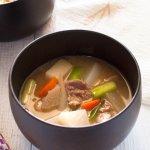
- 150g (5.3oz) pork belly , thinly sliced, cut into bite size pieces (note 1)
- 600ml (20.3oz) dashi stock (note 2)
- 2 tbsp miso (note 3)
- 100g (3.5oz) daikon (white radish), quartered and sliced 7mm thick
- 100g (3.5oz) carrots , halved and sliced 7mm (1/4") thick (note 5)
- ½ konnyaku block , halved lengthwise and sliced 7mm (1/4") thick (note 6)
- 100g (3.5oz) potatoes , cut into 2cm (3/4") cubes
- 40g (1.4oz) burdock , thinly sliced or shredded (note 7)
- 2 shallot (scallion) stems, chopped into 2.5cm (1”) lengths
- Julienned white part of shallots (scallions)
- Shichimi tōgarashi (Japanese spice mixture)
-
Heat a saucepan with a dash of oil (not in ingredients, note 8) and sauté pork over high heat until the surface of the pork is cooked.
-
Add all the vegetables except shallots to the pan and sauté until the surface of the vegetables are cooked (surface becomes semi-transparent in the case of potatoes).
-
Add dashi stock and bring to a boil. Reduce heat to low and cook for about 10 minutes or until vegetables are cooked through.
-
Add miso gradually, diluting into the soup. Add shallots, turn the heat up to medium low and cook for a couple of minutes.
-
Serve hot soup into a standard bowl or a large soup bowl topped with julienned shallots if using accompanied by tōgarashi.
1. You can use any cut of pork as long as it is not for stewing. It is important to slice the meat thinly into bite size pieces so that it cooks faster and is easier to eat.
2. Since the soup will be full of flavour from plenty of vegetables and meat, you can just use water instead. If you use dashi stock, it will add more umami to the soup.
3. Depending on the type of miso, and the brand within the same type of miso, saltiness varies. If you make dashi stock from the granular instant stock powder, it might contain salt as well. So, you will need to adjust the amount of miso by diluting the miso into the soup in stages.
4. The combinations of vegetables used in tonjiru can vary. You can add other vegetables according to what you have. Root vegetables good for stewing should be nice. I have listed some in my blog.
5. If the carrot is fat, you may need to quarter it lengthwise. The idea is to cut the root vegetables into the sizes so that their cooking time are similar.
6. Konnyaku is made from konnyaku potato flour which has the texture of very firm jelly and sold as a block or small balls. You can buy konnyaku at Japanese/Asian grocery stores. Please see my post above for details.
7. Burdock is not commonly sold in Sydney but some Asian vegetable shops or grocery stores sell fresh burdock which is a thin long root. However, you can find shredded or julienned frozen burdock at most Asian/Japanese grocery stores.
8. If the meat does not stick to the bottom of your pot when sautéed, there is no need to add oil since the pork belly contains streaks of fat in itself. I used oil because my pot was not good with it.
If you are using leaner meat, you may want to add a small amount of oil to sauté.